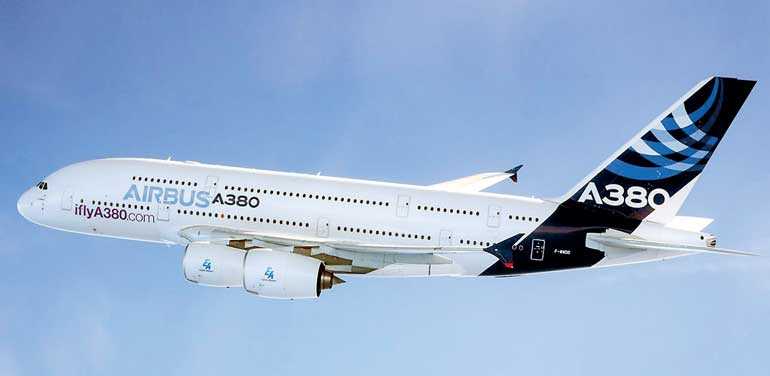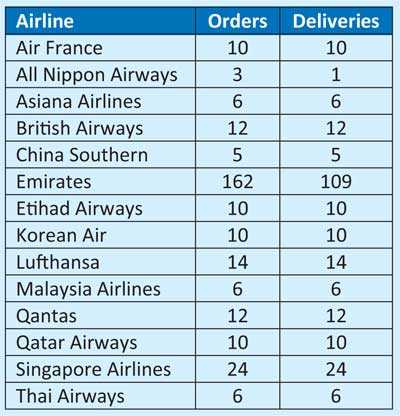Friday Mar 21, 2025
Friday Mar 21, 2025
Monday, 10 June 2019 00:00 - - {{hitsCtrl.values.hits}}

As American author Mark Twain remarked in 1897, “The report of my death was an exaggeration.”
The Airbus A380, flagship of the world’s largest airliner manufacturer and culmination of an estimated $ 16 billion development program, is alive and well. Currently flying with 14 of the world’s most prestigious airlines, with Japan’s All Nippon Airways (ANA) having just taken delivery of its first A380, the giant aircraft is still being produced.

But sadly, A380 production is due to be halted by 2021 when the last aircraft will be delivered to its biggest customer, Emirates. Between now and that date, production will be slowed to about one airframe a month, barely enough to keep the assembly line ticking over.
What happened?
When Airbus began developing the concept of a massive airliner, dubbed the ‘A3XX’ project, the world was a different place. At the time the project was launched, in 1999, jet fuel, which accounts for between 15 to 30% of an airline’s expenses, was at a generational low.
The airline business was booming and Boeing, undisputed leader in the airliner game, was easily profitable, with its venerable 747, appropriately dubbed ‘Queen of the Skies’, a huge profit-generator for the Seattle, Washington-based manufacturer. Airbus was the upstart trying to find a niche for itself while battling the US giants. Determined to have a complete ‘suite’ of airliners, Airbus management decided to launch a rival to the 747.
Boeing was sceptical. Their forecasts showed a totally different market projection and they were not keen on updating the 747. Finally they did so reluctantly, launching the 747-800, but were more focused on creating the 787 Dreamliner – a twin-engine mid-size airliner designed for a more fragmented market.
Emirates Airline, then an upstart too, was an enthusiastic customer for the Airbus A380, being the first to announce an order in April 2000. Air France, Singapore Airlines, Qantas and Virgin Atlantic would follow the same year, showing initial enthusiasm for the type.
Lufthansa and Qatar Airways joined the ‘A380 club’ shortly thereafter, Federal Express ordered the freighter version, and Emirates tripled its A380 order. Airbus was delighted; the flagship was going to fly.
Tellingly though, the major aircraft leasing companies, who are the primary buyers of new airliner types, were very cautious in placing orders for the A380. It was obvious that the market was more sceptical than Airbus.
More complicated than they thought
In reality, flight testing and then producing an aircraft of this complexity proved to be much harder than even Airbus had imagined. Innumerable delays dogged the program, and the A380 missed many delivery milestones. The complex nature of the airliner market means that excessive delays allow the customer to cancel orders with few penalties. As Airbus missed many projections on the delivery timeline, customers began having second thoughts about the viability of the giant, double-deck aircraft.
The aftermath of the World Trade Center attacks in September 2001 dented the confidence of many airlines, just as the A3XX project was launched and oil prices began climbing too.
The US-led invasion of Iraq sent oil prices to a new all-time high. The market reached a peak of almost $ 150 a barrel of oil in 2007, concurrent with the A380 approaching ‘entry into service’. The global financial crisis of 2008 further dented customer confidence, and cancellations started pouring in.
Entry into service
The Airbus A380 was triumphantly and flawlessly launched into service with Singapore Airlines in October 2007, becoming an instant customer favourite. Airbus’ ‘super salesman’ John Leahy confidently forecast demand for over 1,300 aircraft in the ‘very large’ category which included the B747-800 and the Airbus A380.
But the writing was already on the wall. Jet fuel was at an all-time high, the A380 that could weigh up to 570,000 kg when fully loaded with passengers, cargo and fuel, would burn over 13,000 kg of fuel every hour. An empty A380 with no fuel, passengers or cargo on board, still weighed in excess of 300,000 kg.
By contrast, archrival Boeing’s 787 Dreamliner had a maximum weight (full of passengers and freight) of around 239,000 kg, with its two engines burning about 5,000 kg an hour. The contrast was obvious – in a high fuel price world, the Airbus ‘whale’ was just too heavy and thirsty.
Only one lover
Emirates and Qantas introduced the A380 in 2008, with Lufthansa and Air France following soon after. The Airbus sales team worked frantically to gather orders for the ‘whale’. For a while it seemed that they were succeeding. Many of the world’s flag-carriers placed small orders (see box), but only one was a ‘true believer’.
Emirates Airline, led by the forceful and visionary Tim Clark (now Sir Tim), was determined to build a ‘mega hub’ in Dubai. The A380 suited his vision perfectly, bringing in almost 500 passengers per airplane into Dubai, where they would change to another and reach their destination on all six continents that Emirates’ network encompassed.
Emirates uses 162 of the 235 A380s delivered worldwide – a ratio that is totally unprecedented in the industry.
A niche market
A number of airlines that originally ordered the aircraft have cancelled it completely. A few went out of business during the economic slowdown as well. The only lessor with an order, International Finance Lease Corporation (ILFC), cancelled it completely in 2011.
The Airbus A380, flagship of the world’s largest airliner manufacturer and culmination of an estimated $ 16 billion development program, is alive and well. Currently flying with 14 of the world’s most prestigious airlines, with Japan’s All Nippon Airways (ANA) having just taken delivery of its first A380, the giant aircraft is still being produced. But sadly, A380 production is due to be halted by 2021 when the last aircraft will be delivered to its biggest customer, Emirates. Between now and that date, production will be slowed to about one airframe a month, barely enough to keep the assembly line ticking over
As the numbers above show, the A380 has, at best, a niche market. Even the most efficient airlines, with large home markets generating huge passenger numbers, can only seemingly maintain around a dozen A380s. The only exceptions to this are Singapore Airlines, a ‘super-connector’ itself, and Emirates.
However the fact that Singapore Airlines has returned three of the original A380s delivered to the lessor, who has been unable to place these aircraft with other customers, says volumes.
Emirates re-thinks the A380
Even Emirates, the only large user of the aircraft with over half the existing hulls, has now been forced to rethink its commitment.
With Airbus and the major engine manufacturers declining to design a newer and more fuel-efficient A380, Emirates has been compelled to order the smaller A350 model instead.
In a recent statement Sir Tim Clark has mentioned that Emirates plans to retire its fleet of A380s by the mid-2030s.
What is the future of the A380?
No airline will be able to order the A380 from the factory anymore. But numerous units will still be available in the secondary market.
Emirates will, of course, remain a user of the aircraft for the foreseeable future, with at least 15 more years of service envisaged. Most of the flag-carriers such as Lufthansa, Air France and Korean Air will probably continue to use their limited fleets to service capacity-constrained city pairs. Singapore Airlines too will continue operating the aircraft for the same reason. Willie Walsh, CEO of International Airlines Group (IAG), which owns British Airways and Iberia, has gone on record that he may acquire pre-owned A380s, if the “price point is feasible”.
One possible new user could be Turkish Airlines, by some measures the largest airline outside the USA, who has just moved to a brand-new airport outside Istanbul that can accommodate the giant airplanes. The older Atatürk Airport was too small for the A380.
An exercise in hubris
The A380 has proved to be an expensive learning experience for Airbus Industrie. It has now established itself as a major player, holding a market share equal to that of its archrival Boeing. Between them, the two manufacturers have an effective duopoly of the market.
Boeing’s future forecasts have turned out to be more accurate than those of Airbus, with the 787 proving to be the modern aircraft of choice for airlines, as demonstrated by 1,400 orders against 890 for the A350. The list price of the 787 is significantly less than its Airbus rival, but production is sold out for many years. This will probably allow Airbus to claw back some share of the market.
Boeing, meanwhile, is facing a hugely expensive debacle with the 737 MAX programs, which is a topic for another day.
How Airbus will account for the huge development cost of the A380 (estimated at over $ 16 billion) remains to be seen. It is obvious that the 290 firm orders will barely pay the costs of producing the aircraft, with the research and development expense having to be absorbed by profits on other aircraft types in the stable.
While the A380 will continue to delight passengers for a long while, it will also probably be the last “mega project’ that takes to the skies. The jetliner has changed the world in ways no one could foresee just a few decades ago. It is sad to think that we will not see anything this ambitious launched again.
Discover Kapruka, the leading online shopping platform in Sri Lanka, where you can conveniently send Gifts and Flowers to your loved ones for any event including Valentine ’s Day. Explore a wide range of popular Shopping Categories on Kapruka, including Toys, Groceries, Electronics, Birthday Cakes, Fruits, Chocolates, Flower Bouquets, Clothing, Watches, Lingerie, Gift Sets and Jewellery. Also if you’re interested in selling with Kapruka, Partner Central by Kapruka is the best solution to start with. Moreover, through Kapruka Global Shop, you can also enjoy the convenience of purchasing products from renowned platforms like Amazon and eBay and have them delivered to Sri Lanka.
Discover Kapruka, the leading online shopping platform in Sri Lanka, where you can conveniently send Gifts and Flowers to your loved ones for any event including Valentine ’s Day. Explore a wide range of popular Shopping Categories on Kapruka, including Toys, Groceries, Electronics, Birthday Cakes, Fruits, Chocolates, Flower Bouquets, Clothing, Watches, Lingerie, Gift Sets and Jewellery. Also if you’re interested in selling with Kapruka, Partner Central by Kapruka is the best solution to start with. Moreover, through Kapruka Global Shop, you can also enjoy the convenience of purchasing products from renowned platforms like Amazon and eBay and have them delivered to Sri Lanka.